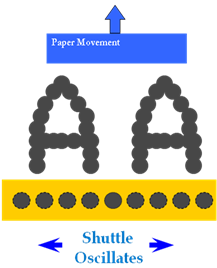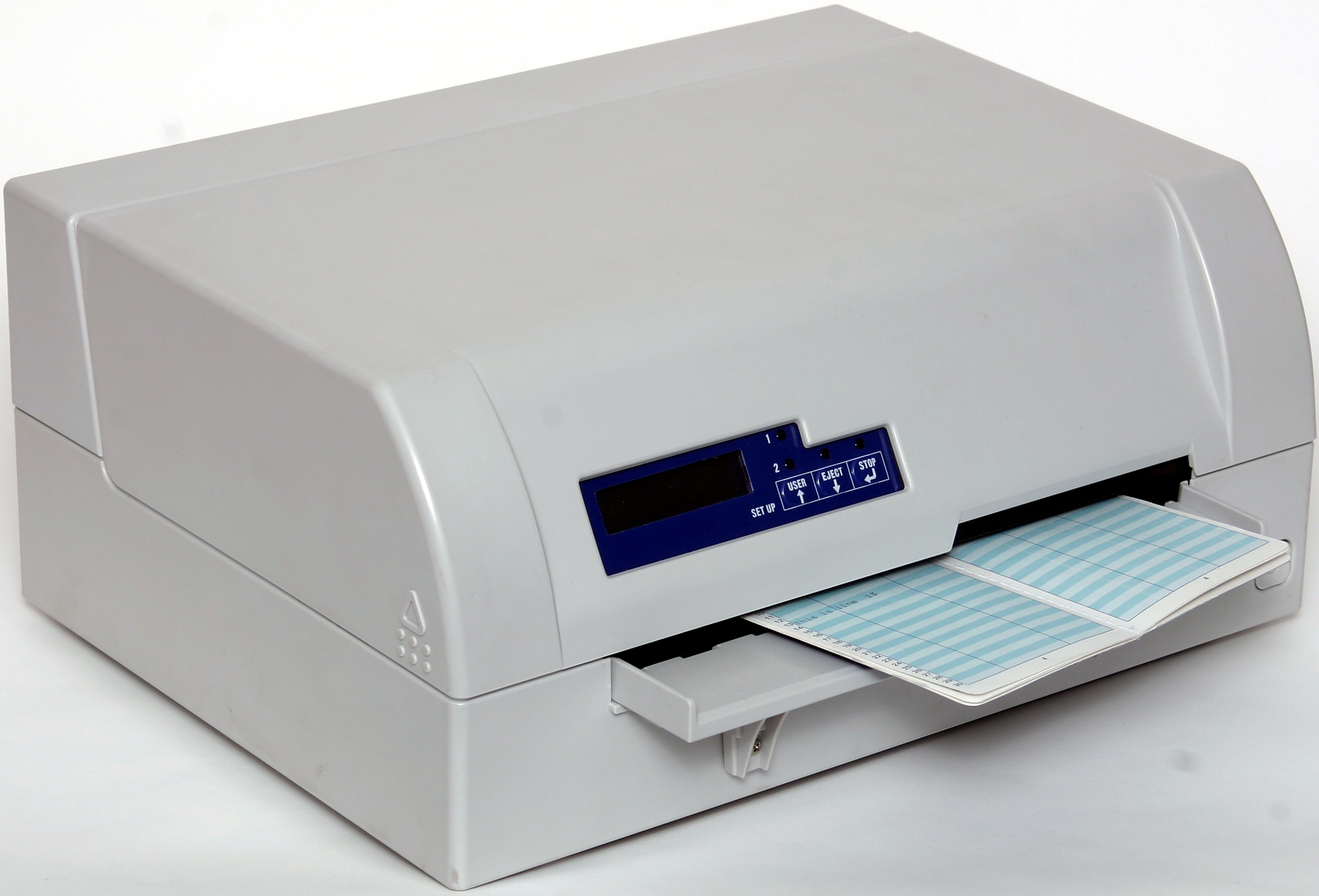|
Line Matrix Printer
A line matrix printer is a computer printer that is a compromise between a line printer and a dot matrix printer. A line matrix printer prints page-wide lines of dots at a time, building up a line of text by printing lines of dots. Applications Line matrix printers are used for high-speed printing applications They are used to produce invoices, bank statements, product shipment and transportation documentation as well as product compliance labels. Line matrix printers can print text, bar codes and graphics. When implemented as impact printers, they can be the least expensive to operate per page. How it works Dot matrix printers are widely used because of their low cost per page. Dot matrix printers are divided into two main groups: serial dot matrix printers and line matrix printers. A serial dot matrix printer has a print head that runs back and forth, or in an up and down motion, on the page and prints by impact, striking an ink-soaked cloth ribbon against the paper, ... [...More Info...] [...Related Items...] OR: [Wikipedia] [Google] [Baidu] |
Computer Printer
A printer is a peripheral machine which makes a durable representation of graphics or text, usually on paper. While most output is human-readable, bar code printers are an example of an expanded use for printers. Different types of printers include 3D printers, inkjet printers, laser printers, and thermal printers. History The first computer printer designed was a mechanically driven apparatus by Charles Babbage for his difference engine in the 19th century; however, his mechanical printer design was not built until 2000. He also had plans for a curve plotter, which would have been the first computer graphics printer if it was built. The first patented printing mechanism for applying a marking medium to a recording medium or more particularly an electrostatic inking apparatus and a method for electrostatically depositing ink on controlled areas of a receiving medium, was in 1962 by C. R. Winston, Teletype Corporation, using continuous inkjet printing. The ink was a red sta ... [...More Info...] [...Related Items...] OR: [Wikipedia] [Google] [Baidu] |
Lineprinter
A line printer Printer (computing), prints one entire line of text before advancing to another line. Most early line printers were printer (computing)#Impact printers, impact printers. Line printers are mostly associated with unit record equipment and the early days of digital computing, but the technology is still in use. Print speeds of 600 lines per minute (approximately 10 pages per minute) were achieved in the 1950s, later increasing to as much as 1200 lpm. Line printers print a complete line at a time and have speeds in the range of 150 to 2500 lines per minute. Some types of impact line printers are #Drum printer, drum printers, #Band printer, band-printers, and #Chain printer, chain printers. Non-impact technologies have also been used, e.g., thermal printing, thermal line printers were popular in the 1970s and 1980s, some inkjet and laser printers produce output a line or a page at a time. Designs Many impact printers, such as the daisywheel printer and dot matri ... [...More Info...] [...Related Items...] OR: [Wikipedia] [Google] [Baidu] |
Dot Matrix Printer
Dot matrix printing, sometimes called impact matrix printing, is a computer printing process in which ink is applied to a surface using a relatively low-resolution dot matrix for layout. Dot matrix printers are a type of impact printer that prints using a fixed number of pins or wires and typically use a print head that moves back and forth or in an up-and-down motion on the page and prints by impact, striking an ink-soaked cloth ribbon against the paper. They were also known as serial dot matrix printers. Unlike typewriters or line printers that use a similar print mechanism, a dot matrix printer can print arbitrary patterns and not just specific characters. The perceived quality of dot matrix printers depends on the vertical and horizontal resolution and the ability of the printer to overlap adjacent dots. 9-pin and 24-pin are common; this specifies the number of pins in a specific vertically aligned space. With 24-pin printers, the horizontal movement can slightly overlap ... [...More Info...] [...Related Items...] OR: [Wikipedia] [Google] [Baidu] |
Barcode Printer
A barcode printer is a computer peripheral for printing barcode labels or tags that can be attached to, or printed directly on, physical objects. Barcode printers are commonly used to label cartons before shipment, or to label retail items with UPCs or EANs. The most common barcode printers employ one of two different printing technologies. Direct thermal printers use a printhead to generate heat that causes a chemical reaction in specially designed paper that turns the paper black. Thermal transfer printers also use heat, but instead of reacting the paper, the heat melts a waxy or resin substance on a ribbon that runs over the label or tag material. The heat transfers ink from the ribbon to the paper. Direct thermal printers are generally less expensive, but they produce labels that can become illegible if exposed to heat, direct sunlight, or chemical vapors. Barcode printers are designed for different markets. Industrial barcode printers are used in large warehouses an ... [...More Info...] [...Related Items...] OR: [Wikipedia] [Google] [Baidu] |



